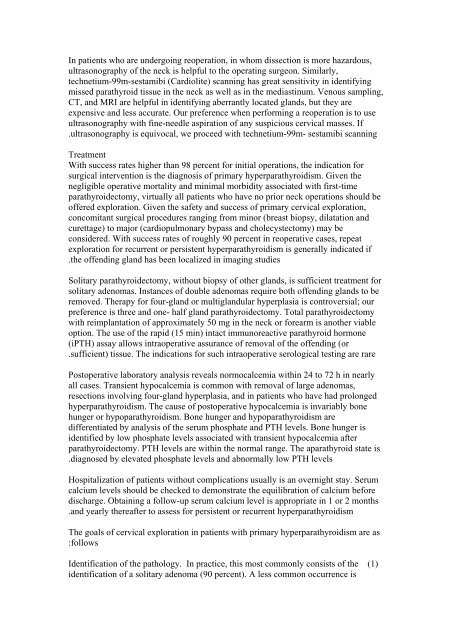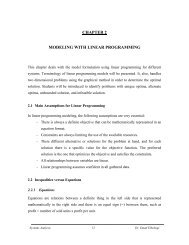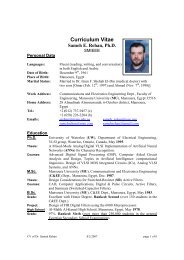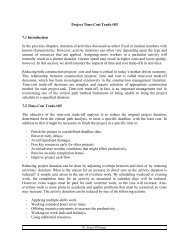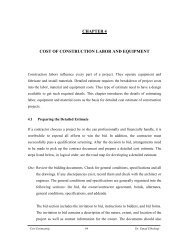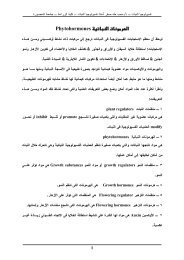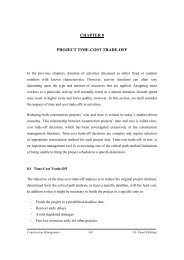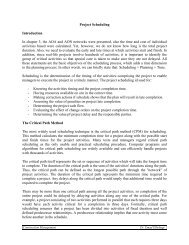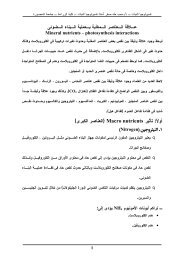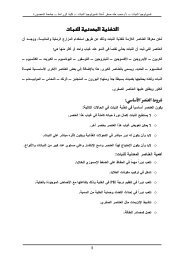Thyroid and Parathyroid
Thyroid and Parathyroid
Thyroid and Parathyroid
You also want an ePaper? Increase the reach of your titles
YUMPU automatically turns print PDFs into web optimized ePapers that Google loves.
In patients who are undergoing reoperation, in whom dissection is more hazardous,<br />
ultrasonography of the neck is helpful to the operating surgeon. Similarly,<br />
technetium-99m-sestamibi (Cardiolite) scanning has great sensitivity in identifying<br />
missed parathyroid tissue in the neck as well as in the mediastinum. Venous sampling,<br />
CT, <strong>and</strong> MRI are helpful in identifying aberrantly located gl<strong>and</strong>s, but they are<br />
expensive <strong>and</strong> less accurate. Our preference when performing a reoperation is to use<br />
ultrasonography with fine-needle aspiration of any suspicious cervical masses. If<br />
. ultrasonography is equivocal, we proceed with technetium-99m- sestamibi scanning<br />
Treatment<br />
With success rates higher than 98 percent for initial operations, the indication for<br />
surgical intervention is the diagnosis of primary hyperparathyroidism. Given the<br />
negligible operative mortality <strong>and</strong> minimal morbidity associated with first-time<br />
parathyroidectomy, virtually all patients who have no prior neck operations should be<br />
offered exploration. Given the safety <strong>and</strong> success of primary cervical exploration,<br />
concomitant surgical procedures ranging from minor (breast biopsy, dilatation <strong>and</strong><br />
curettage) to major (cardiopulmonary bypass <strong>and</strong> cholecystectomy) may be<br />
considered. With success rates of roughly 90 percent in reoperative cases, repeat<br />
exploration for recurrent or persistent hyperparathyroidism is generally indicated if<br />
. the offending gl<strong>and</strong> has been localized in imaging studies<br />
Solitary parathyroidectomy, without biopsy of other gl<strong>and</strong>s, is sufficient treatment for<br />
solitary adenomas. Instances of double adenomas require both offending gl<strong>and</strong>s to be<br />
removed. Therapy for four-gl<strong>and</strong> or multigl<strong>and</strong>ular hyperplasia is controversial; our<br />
preference is three <strong>and</strong> one- half gl<strong>and</strong> parathyroidectomy. Total parathyroidectomy<br />
with reimplantation of approximately 50 mg in the neck or forearm is another viable<br />
option. The use of the rapid (15 min) intact immunoreactive parathyroid hormone<br />
(iPTH) assay allows intraoperative assurance of removal of the offending (or<br />
. sufficient) tissue. The indications for such intraoperative serological testing are rare<br />
Postoperative laboratory analysis reveals normocalcemia within 24 to 72 h in nearly<br />
all cases. Transient hypocalcemia is common with removal of large adenomas,<br />
resections involving four-gl<strong>and</strong> hyperplasia, <strong>and</strong> in patients who have had prolonged<br />
hyperparathyroidism. The cause of postoperative hypocalcemia is invariably bone<br />
hunger or hypoparathyroidism. Bone hunger <strong>and</strong> hypoparathyroidism are<br />
differentiated by analysis of the serum phosphate <strong>and</strong> PTH levels. Bone hunger is<br />
identified by low phosphate levels associated with transient hypocalcemia after<br />
parathyroidectomy. PTH levels are within the normal range. The aparathyroid state is<br />
. diagnosed by elevated phosphate levels <strong>and</strong> abnormally low PTH levels<br />
Hospitalization of patients without complications usually is an overnight stay. Serum<br />
calcium levels should be checked to demonstrate the equilibration of calcium before<br />
discharge. Obtaining a follow-up serum calcium level is appropriate in 1 or 2 months<br />
. <strong>and</strong> yearly thereafter to assess for persistent or recurrent hyperparathyroidism<br />
The goals of cervical exploration in patients with primary hyperparathyroidism are as<br />
: follows<br />
Identification of the pathology. In practice, this most commonly consists of the<br />
identification of a solitary adenoma (90 percent). A less common occurrence is<br />
( 1)


